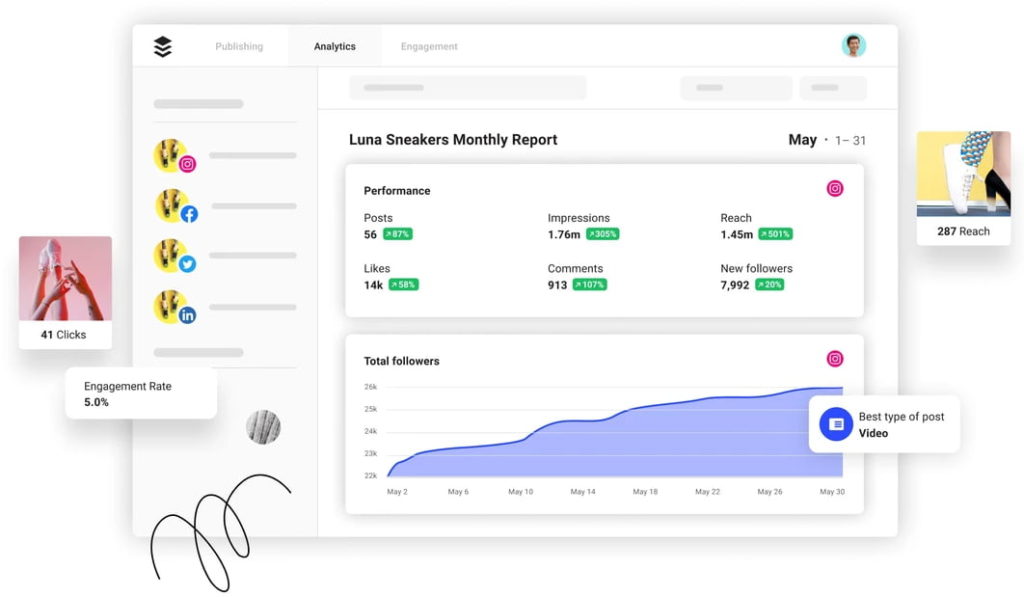Instagram is huge. With more than a billion active monthly users and more than 500 million active daily users, you need to have an Instagram content strategy to stand out from the crowd. Whether you are an Instagram influencer, a social media marketer, or an affiliate marketer, if you use Instagram for any kind of marketing, you need to know how to create an Instagram content strategy.
Content strategy helps you keep track of content, measure content performance, and grow your follower quantity and quality. This article outlines the exact steps you need to follow to create an Instagram content strategy.
How to Create an Instagram Content Strategy
Content strategy is the planning, development, and management of content. It isn’t just limited to a content calendar. Content strategy is a broader term that governs content creation, publication, promotion, tracking, management, and more.
Content strategy has the following steps:
- Setting goals
- Content planning
- Content creation and scheduling
- Analysis.
1. Setting Goals
Your Instagram content strategy begins by setting clear objectives. Creating goals is easy. All you have to do is ask yourself the following question:
What do I want to achieve with my content strategy?
There has to be something you want to achieve by posting content on Instagram, right? It could be:
- More followers
- Awareness or fame
- Authority in your niche
- Make money
- Promote your business
- Partner with a brand.
You need to identify your goal using SMART goals:

Your goal needs to be:
- Specific
- Measurable
- Attainable
- Relevant
- Time-bound.
For example, your goal might be to increase the number of followers. Simply stating this as your goal won’t work as it isn’t specific and has no time limit attached to it.
Here is how the same goal now makes more sense: Increase the number of followers by 10,000 in 2 months.
This goal is specific, measurable, attainable and realistic, relevant since you can acquire followers using content, and has a time limit attached to it.
You can set one or more SMART goals for the content strategy you are creating for Instagram. Goals don’t just give you direction but they help you track and measure performance.
2. Content Panning
Once you have set goals, you’ll have a clear picture of what type of content to create that will help you achieve your goal in the desired time period. Content planning is the key to creating awesome content:
Here is what content planning involves:
- Content ideas and topics
- Content format
- Structure and design.
Content planning begins by identifying key themes and ideas that you’ll create content around. Use hashtags to find engaging content topics relevant to your niche. Once you have the complete list of topics that you want to cover, identify the content format (e.g. text, video, image, graphics, etc.). Ideally, you must publish content in all formats.
Finally, decide on the content design (e.g. photo editing), content structure (what topic to cover first and on a priority basis), and the voice and tone of the content you want to develop.
It is best to use Google Sheets, Airtable, or any other tool for content planning to keep things organized.
3. Content Creation and Scheduling
It is time to create content. You have two options:
- Create content yourself (Read this guide on how to create content for details)
- Outsource content creation.
Instagram is all about photos so your main content should be photos and images. If you can take quality photos from your phone or camera, and know how to edit them professionally, you are good to go. Else, look for a professional.
At the end of the day, it all comes down to your resources. If you are a new Instagram influencer or an affiliate marketer who has started recently, outsourcing won’t be a nice idea. You’ll have to create content in-house.
Marketers and businesses with enough resources can outsource content creation.
In any case, you’ll need to have a content calendar or social media content calendar to manage content creation and scheduling. If you are creating content yourself, a simple Google Sheet will work:
For scheduling content on Instagram, you’ll have to use a tool like Buffer. You can use its free plan that is more than enough to keep you going. You can also look for other social media management tools like Hootsuite that do much more than scheduling.
Use these tools to schedule and publish content on Instagram once it has been created. These aren’t content creation tools.
4. Analysis
Often ignored, tracking and analysis should be an important part of your Instagram content strategy. Once you start publishing content, you need to constantly monitor progress. See if the content you are publishing is performing as expected.
Is it really helping you achieve the goals you set?
If you’ll ignore analysis and reporting, you’ll realize at the end of the month that the content you published isn’t working. It will be nothing but a waste of resources.
This is why you need to use analytics as much as you can. If you are using a tool (like Buffer or Hootsuite), you get all the details in the analytics section:

Alternately, Instagram Insights provides you with all the details you need to monitor progress and performance:
Content analysis helps you identify bugs and you can tweak your content strategy based on results before it gets too late. It also helps you identify top posts and content types that you followers love interacting with.
You can use data-driven content topics to quickly adjust your content strategy accordingly. For example, if you see that posts with photos outperform video posts by 9%, you can tweak your content format and start focusing on photos and images.
Final Thoughts
Creating an Instagram content strategy isn’t a one-time task. You need to constantly update and revise your strategy, content topics, content formats, publishing frequency, and more based on data generated by the analytics tool and/or Instagram Insights.
This means you have to actively monitor content performance preferably on a daily basis.
Updating and tweaking your Instagram content strategy is essential if you want to stay ahead of your competitors and want to impress your audience with awesome content.
Featured Image: Pexels






